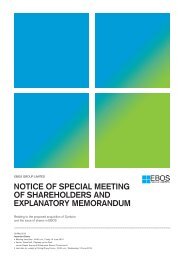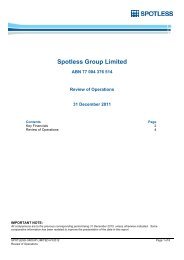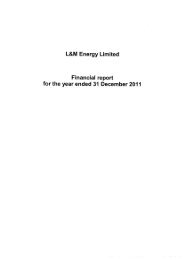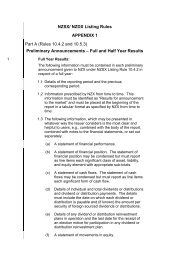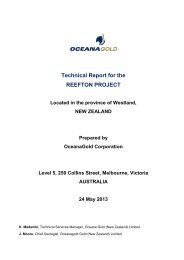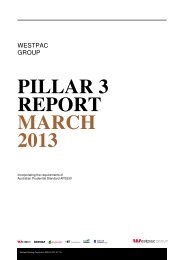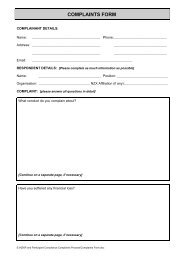New Image Annual Report 2012 concept.indd - NZX
New Image Annual Report 2012 concept.indd - NZX
New Image Annual Report 2012 concept.indd - NZX
You also want an ePaper? Increase the reach of your titles
YUMPU automatically turns print PDFs into web optimized ePapers that Google loves.
Notes to and forming part of the financial<br />
statements (continued)<br />
For the year ended 30 June <strong>2012</strong><br />
26<br />
An impairment loss in respect of goodwill is not<br />
reversed. In respect of other assets impairment<br />
losses recognised in prior periods are assessed at<br />
each reporting date for any indications that the<br />
loss has decreased or no longer exists. An<br />
impairment loss is reversed if there has been a<br />
change in the estimates used to determine the<br />
recoverable amount. An impairment loss is<br />
reversed only to the extent that the asset’s<br />
carrying amount does not exceed the carrying<br />
amount that would have been determined, net of<br />
depreciation or amortisation, if no impairment<br />
loss had been recognised.<br />
N Share Capital<br />
Ordinary shares are classified as equity.<br />
Incremental costs directly attributable to the<br />
issue of new shares are shown in equity as a<br />
deduction net of tax from the proceeds.<br />
Repurchase of share capital<br />
When share capital recognised as equity is<br />
repurchased, the amount of the consideration<br />
paid, including directly attributable costs, is<br />
recognised as a change in equity. Repurchased<br />
shares are classified as treasury shares and<br />
presented as a deduction from total equity.<br />
O Employee Benefits<br />
Liabilities for wages and salaries, including<br />
non-monetary benefits and annual leave<br />
expected to be settled within twelve months of<br />
the reporting date are recognised in other<br />
payables in respect of employees’ services up to<br />
the reporting date and are measured at the<br />
amounts expected to be paid when the liabilities<br />
are settled on an undiscounted basis.<br />
P Dividends<br />
Dividends are recognised as a liability in the<br />
period in which they are declared.<br />
Q Interest-bearing Loans and<br />
Borrowings<br />
All loans and borrowings are recognised initially<br />
at fair value of the consideration received less<br />
any directly attributable transaction costs.<br />
Subsequent to initial recognition, interest-bearing<br />
loans and borrowings are measured at amortised<br />
cost with any difference between cost and<br />
maturity value being recognised in the Statement<br />
of Comprehensive Income over the period of the<br />
borrowings on an effective interest basis.<br />
Loans and borrowings are classified as current<br />
liabilities unless the Group has an unconditional<br />
right to defer settlement of the liability for at<br />
least 12 months after the reporting date.<br />
Borrowing costs<br />
Borrowing costs directly attributable to the<br />
acquisition, construction or production of the<br />
qualifying asset (i.e. an asset that necessarily<br />
takes a substantial period of time to get ready for<br />
its intended use or sale) are capitalised as part of<br />
the cost of that asset. All other borrowing costs<br />
are expensed in the period they are incurred.<br />
Borrowing costs consist of interest and other<br />
costs that an entity incurs in connection with the<br />
borrowing of funds.<br />
R Provisions<br />
A provision is recognised in the Statement of<br />
Financial Position when the Group has a present<br />
legal or constructive obligation as a result of a<br />
past event, and it is probable that an outflow of<br />
resources embodying economic benefits will be<br />
required to settle the obligation and a reliable<br />
estimate can be made of the amount of the<br />
obligation.<br />
When the Group expects some or all of a<br />
provision to be reimbursed, for example under an<br />
insurance contract, the reimbursement is<br />
recognised as a separate asset but only when the<br />
reimbursement is virtually certain. The expense<br />
relating to any provision is presented in the<br />
Statement of Comprehensive Income net of any<br />
reimbursement.<br />
Provisions are measured at the present value of<br />
management’s best estimate of the expenditure<br />
required to settle the present obligation at the<br />
reporting date. The discount rate used to<br />
determine the present value reflects current<br />
market assessments of the time value of money<br />
and the risks specific to the liability. The increase<br />
in the provision resulting from the passage of<br />
time is recognised in finance costs.<br />
S Revenue<br />
Revenue from the sale of goods is recognised in<br />
the Statement of Comprehensive Income at the<br />
fair value of the consideration received or<br />
receivable, net of returns, trade discounts and<br />
volume rebates. Revenue from the sale of goods<br />
is recognised when there is persuasive evidence,<br />
usually in the form of an executed sales<br />
agreement at the time of delivery of the goods to<br />
the customer, indicating there has been a transfer<br />
of risk and rewards to the customer, the quantity<br />
and quality of the goods has been determined<br />
and the price is fixed.<br />
No revenue is recognised if there are significant<br />
uncertainties regarding recovery of the<br />
consideration due, associated costs or there is<br />
continuing management involvement with the<br />
goods and the amount of revenue cannot be<br />
reliably measured.<br />
Interest income is recognised in the Statement of<br />
Comprehensive Income as it accrues, using the<br />
effective interest method.<br />
T Leases<br />
The determination of whether an arrangement is<br />
or contains a lease is based on the substance of<br />
the arrangement at inception date, whether<br />
fulfilment of the arrangement is dependent on<br />
the use of a specific asset or assets or the<br />
arrangement conveys a right to use the asset,<br />
even if that right is not explicitly specified in an<br />
arrangement.<br />
Group as a Lessee<br />
Finance leases, which transfer to the Group<br />
substantially all the risks and benefits incidental<br />
to ownership of the leased item, are capitalised at<br />
the inception of the lease at the fair value of the<br />
leased asset or, if lower, at the present value of<br />
the minimum lease payments. Lease payments<br />
are apportioned between the finance charges and<br />
reduction of the lease liability so as to achieve a<br />
constant rate of interest on the remaining balance<br />
of the liability. Finance charges are recognised in<br />
finance costs in the Statement of Comprehensive<br />
Income.<br />
Capitalised leased assets are depreciated over<br />
the shorter of the estimated useful life of the<br />
asset and the lease term if there is no reasonable<br />
certainty that the Group will obtain ownership by<br />
the end of the lease term.<br />
Operating lease payments are recognised as an<br />
operating expense in the Statement of<br />
Comprehensive Income on a straight-line basis<br />
over the lease term. Operating lease incentives<br />
received are recognised as a liability when<br />
received and subsequently reduced by allocating<br />
lease payments between rental expense and<br />
reduction of the liability.<br />
Group as a Lessor<br />
Leases in which the Group retains substantially all<br />
the risks and benefits of ownership of the leased<br />
asset are classified as operating leases. Initial<br />
direct costs incurred in negotiating an operating<br />
lease are added to the carrying amount of the<br />
leased asset and recognised as an expense over<br />
the lease term on the same basis as rental<br />
income. Contingent rents are recognised as<br />
revenue in the period in which they are earned.<br />
U Income Tax and Other Taxes<br />
Income tax on the profit or loss for the year<br />
comprises current and deferred tax. Income tax is<br />
recognised in the Statement of Comprehensive<br />
Income except to the extent that it relates to<br />
items recognised directly in equity, in which case<br />
it is recognised in equity.<br />
27<br />
NEW IMAGE GROUP ANNUAL REPORT<br />
NEW IMAGE GROUP ANNUAL REPORT



